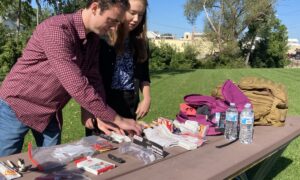Washington — New evidence bolsters the notion that deep saline groundwaters in South Africa’s Witwatersrand Basin may have remained isolated for many thousands, perhaps even millions, of years.
The study, recently accepted for publication in Chemical Geology, found the noble gas neon dissolved in water in three-kilometre deep crevices.
The unusual neon profile, along with the high salinities and some other unique chemical signatures, is very different from anything seen in molten fluid and gases rising from beneath the Earth’s crust, according to University of Toronto professor Barbara Sherwood Lollar, who is the Canadian member of the international team that produced the results.
“The chemical signatures also don’t match those of ocean water or waters higher up in the Witwatersrand Basin, where as in most regions of the crust ground waters show evidence of mixing with surface waters and are extensively colonized by microorganisms,” she said. “We concluded that the deeper waters were the product of isolation and extensive chemical interaction between water and rock over incredibly long geological time scales.”
The smoking gun was the ancient basement rock.
“We know that this specific neon isotope signature was produced and trapped within the rock at least two billion years ago. We can still find it there today,” Dr. Sherwood Lollar said. “The study shows some of the neon found its way outside of the rock minerals, gradually dissolving into, and accumulating in, fluids in crevices. This could only happen in waters that have indeed been cut off from the surface for extremely long time periods.”
The discovery adds yet another dimension to what has only recently been recognized as a truly unique environment.

One of these fracture systems contains the deepest known microbial ecosystems on Earth. These are organisms that eke out an existence independent from sunlight on chemical energy that originates from rock.
“These deep microbial communities radically expand our concept of the habitability of the Earth’s subsurface and, indeed, our biosphere,” said Dr. Sherwood Lollar.
“Given that they have a genetic similarity to organisms found at hydrothermal vents, we assume this is not a separate origin of life, but instead these organisms arrived from elsewhere to colonize these rocks in ancient times,” she said.
“Clearly the long period of isolation affected their evolution. This is one area we hope to explore with continuing research with our microbiology colleagues.”
The lead author of the paper is Johanna Lippmann-Pipke of the Helmholtz-Zentrum Dresden-Rossendorf in Leipzig, Germany. Researchers from that country, South Africa, the United States and Canada participated in the study.
Dr. Sherwood Lollar will be available to discuss the new findings at this year’s meeting of the American Association for the Advancement of Science (AAAS) in Washington, DC. On Sunday, February 20, she will take part in a panel discussion on global water issues at the Think Canada Press Breakfast.
http://www.eurekalert.org/pub_releases/2011-02/nsae-two021911.php





